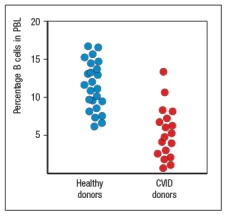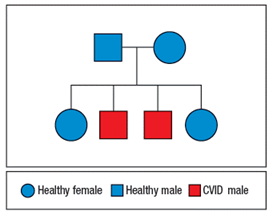Essay
Common variable immunodeficiency (CVID) is a rather mild immunodeficiency disease that generally appears in young adults, with a peak onset between ages 20-30. Approximately 25% of the cases of CVID are familial, indicating a genetic basis for the disease. CVID patients suffer from recurrent infections of the respiratory tract, the ears, and the gastrointestinal tract. Common infections in these patients are caused by Haemophilus influenzae, Streptococcus pneumoniae and Staphylococcus aureus. Analysis of their peripheral blood cells shows normal numbers and subsets of T cells. B cell data from peripheral blood are shown in Figure : 
a) In general, what is the immune mechanism most likely defective in patients with CVID? Explain your reasoning.
One particular family is chosen for further study. In this family, two of four children have CVID, as shown in Figure 
Given this pedigree, the mother’s peripheral blood leukocytes are examined for their patterns of X-chromosome inactivation. The results show that all of her T cells, B cells, and monocytes show random (50:50) inactivation of each of her X chromosomes.
b) What do these data indicate about the gene defect causing CVID in this family?
In a second series of studies, peripheral blood cells from one CVID patient and one healthy child in this family were collected, and T cell and B cell populations were separately isolated. These cell populations were mixed in different combinations, and then cultured for one week in the cytokines IL-4, IL-21, and IL-6. At the end of one week, the concentrations of secreted antibody in the culture supernatants were measured 
c) What do these data indicate about the gene defect causing CVID in this family?
In a final set of experiments, the isolated T cells and B cells from the study above were used in a transwell assay. In this assay, shown in Figure , cell populations are separated by a semi-permeable membrane. This allows soluble mediators to equilibrate between the top and bottom chambers, but prevents direct cell–cell contact.
As a control, the cell populations were mixed together in the bottom chamber, a result that would replicate the findings from the study above. In addition, in this study, all wells contained IL-4, IL-6, and IL-21. After 7 days, culture supernatants were analyzed for antibody concentrations.The results of the transwell experiments are shown in Table .

d) What do these data indicate about the function of the gene that is defective in the CVID patients from this family?
Correct Answer:

Verified
a) Antibody production.
The susceptibili...View Answer
Unlock this answer now
Get Access to more Verified Answers free of charge
Correct Answer:
Verified
The susceptibili...
View Answer
Unlock this answer now
Get Access to more Verified Answers free of charge
Q33: A variety of genetic defects can result
Q34: Bone marrow transplantation is currently used to
Q35: One important feature of retroviruses such as
Q36: Infants with RS-SCID generally require treatment by
Q37: The first drug treatment for HIV licensed
Q39: A mouse model of an immunodeficiency
Q40: Listeria monocytogenes is a Gram-positive facultative
Q41: Human genome-wide genetic association (GWAS) studies have
Q42: Defects in components of the complement pathway
Q43: A common misconception is that our immune